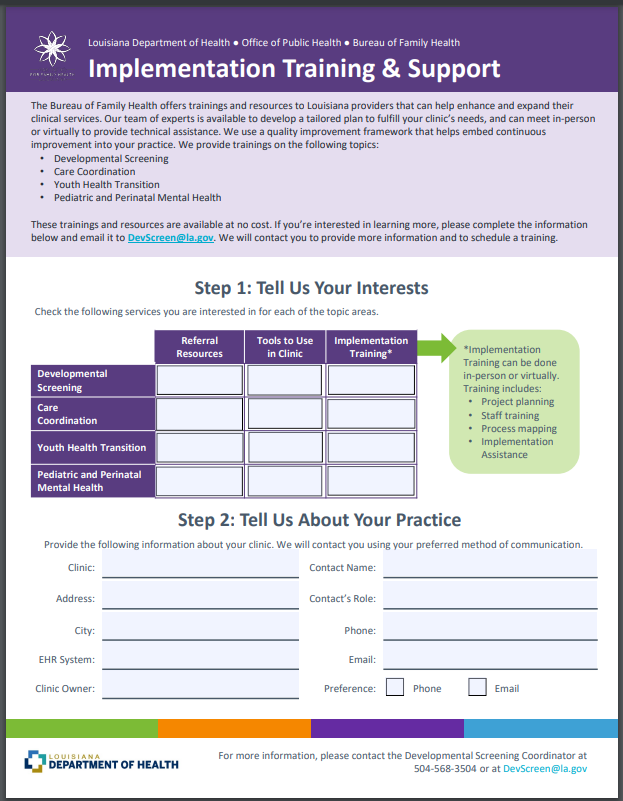Care Coordination Training and Support
Implementing changes in your practice can feel like a daunting task. From creating a plan, to training staff and making the changes in services, there is a lot of coordination that needs to take place.
While there are many resources available to help guide this process, we also have a team of experts available to provide Implementation Training and Support (ITS). You can use this request form or click the image to the right to learn more about the topics we can help with and the services we offer.
Care Coordination ITS consists of a variety of options that allow you to interact with our experts to receive support tailored to your practice's wants and needs.
We can provide guidance, help with decision-making and problem-solving, and coach you through implementing changes in your practice.
Quality Improvement
 Quality improvement (QI) is the framework used to systematically improve the way health care is delivered to patients. It refers to the process of planning and testing changes on a small scale, with the goal of implementing them across the entire practice. Plan-Do-Study-Act (Step 3 of this toolkit) is a popular QI framework. Using evidence-based QI strategies while implementing care coordination elements will strengthen your clinic’s services and provide staff with the tools to improve efficiency, patient safety, and clinical outcomes.
Quality improvement (QI) is the framework used to systematically improve the way health care is delivered to patients. It refers to the process of planning and testing changes on a small scale, with the goal of implementing them across the entire practice. Plan-Do-Study-Act (Step 3 of this toolkit) is a popular QI framework. Using evidence-based QI strategies while implementing care coordination elements will strengthen your clinic’s services and provide staff with the tools to improve efficiency, patient safety, and clinical outcomes.
Building clinic QI capacity does not have to be costly or overwhelming. Evidence tells us that selecting a QI method and using it consistently is key to success! Many no and low-cost, evidence-based QI trainings provide the framework needed to get started. The resources listed below can be used to better understand QI and how to use the PDSA framework.
Quality Improvement Resources
-
American Academy of Pediatrics (AAP) Quality Improvement in the Pediatric Practice - Tutorial: An introduction to QI and the PDSA framework. Topics covered include the basics of QI, creating a QI team, and how to complete a PDSA.
-
The National Institute for Children’s Health Quality (NICHQ) Quality Improvement Virtual Training: Self-directed courses that introduce quality improvement science concepts.
American Board of Pediatrics Maintenance of Certification 4 (MOC-4) Credits
This toolkit can be used as an American Board of Pediatrics MOC-4 project for providers who are heavily involved in leading the QI efforts. Review the checklist, application questions, and project examples so you know what you’ll need to submit to qualify for credits. Find more information about the American Board of Pediatrics MOC-4 credits here.
Sustainability
 Sustainability refers to holding the gains of an improvement project, even in the face of staff and organizational turnover. Without sustainability, valuable time and resources are wasted investing in organizational improvement. Due to the high level of variability in health care, quality improvement must be continuously integrated into an organization's culture in order to provide high-quality care and reliable safe practices.
Sustainability refers to holding the gains of an improvement project, even in the face of staff and organizational turnover. Without sustainability, valuable time and resources are wasted investing in organizational improvement. Due to the high level of variability in health care, quality improvement must be continuously integrated into an organization's culture in order to provide high-quality care and reliable safe practices.
Signs of Sustainability
Recognizing when a quality improvement project is ready to be sustained or implemented can be challenging, but several signs exist. When a project exhibits the signs listed below, it suggests that the initial phase of improvement work is complete and you are ready to create a sustainability plan.
-
The changes have been tested in different conditions with different staff, each providing feedback on performance.
-
The necessary infrastructure (personnel, supplies, equipment) exists to support the project long-term.
-
The project has achieved a high level of performance for several weeks/months.
-
Measures have been identified to monitor performance over time, along with the responsibility assigned for performance measurement and reporting.
Developing a Sustainability Action Plan
You will need to better understand, assess, and review the factors that influence a clinical practice’s capacity for sustainability, then develop an action plan to increase the likelihood of sustainability. The Agency for Healthcare Research and Quality (AHRQ) created the Clinical Sustainability Assessment Tool to help with this.

Once you assess your clinic’s capacity to sustain your new care coordination element, you can start to develop a Sustainability Action Plan. The AHRQ tool has the plan broken out into the following steps:
-
Assemble the planning team
-
Review your practice’s goals
-
Review your Clinical Sustainability Assessment Tool results
-
Determine which practice elements need to be maintained, eliminated, or adapted
-
Prioritize the areas of sustainability capacity to address first.
-
Write a Sustainability Action Plan with specific action steps.
Once you have your sustainability plan documented, you can start carrying out the action steps and then reevaluate the plan on an annual basis.
Remember to recognize and celebrate successes along the way - it is important for implementation and long-term sustainability.
 Official Louisiana State Websites use .la.gov
Official Louisiana State Websites use .la.gov  Secure .gov websites use HTTPS
Secure .gov websites use HTTPS 
